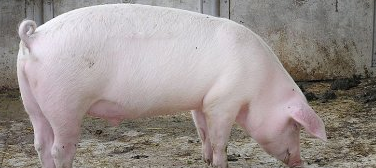
The Swine Genome Sequencing Consortium (SGSC) was formed in September 2003 by academic, government and industry representatives to provide international coordination for sequencing the pig genome.
The SGSC's mission is to advance biomedical research for animal production and health by the development of DNA based tools and products resulting from the sequencing of the swine genome.
A physical map of the swine genome was generated by an international collaboration of four laboratories, led by the Wellcome Trust Sanger Institute and Dr. Lawrence Schook at the University of Illinois at Urbana-Champaign. Both high-throughput fingerprinting and BAC-end sequencing were used to provide the template for an integrated physical map of the whole pig genome.
A high-quality draft genome sequence for the pig (Sus scrofa) was published in Nature in 2012. The paper entitled "Analyses of pig genomes provide insight into porcine demography and evolution" described the sequencing, analysis, and annotation of the draft genome sequence. In parallel, a series of companion papers was published in BMC journals.
The genome paper reports analyses not only of the reference genome of Duroc 2-14 (aka. TJ Tabasco), but also analyses of genomes of several wild boars and other domesticated pigs. The analyses revealed a deep phylogenetic split between European and Asian wild boars dating back ~1 million years. This observation, in part, provides final justification for the wide trait mapping crosses developed in the 1990s, especially between Western and Chinese breeds. It was argued at the time that Chinese and Western pigs were as genetically divergent as Mus musculus and Mus spretus, species of mice which had been extensively used in mouse genetics research. In effect, this judgment has been validated.
As observed in other genomes, genes encoding immune response functions show evidence of rapid evolution. The pig has the largest repertoire of functional olfactory receptor genes of any mammal sequenced to date – perhaps that is why they are effective hunters for truffles. There is evidence that genes involved in taste are located in pig evolutionary break points. Pigs can tolerate higher levels of substances that are distasteful to humans – perhaps the ability of pigs to eat material that is unpalatable to humans was one of the attractions when they were domesticated.
A comparison of multiple pig genomes and the comparison of pig and human genomes reveal several potentially disease-causing genetic variants which may extend the value of pigs in biomedical research.
The pig industry has an excellent track record for rapid and effective exploitation of new knowledge and technologies. The pig genome sequence is expected to enable the acceleration of pig genetics research, the results of which are expected to be translated into pig improvement in a timely manner. The pig industry support for the sequencing project is gratefully acknowledged by the Consortium.
This paper represents an important landmark for the Consortium. For many of the authors their collaborative research in pig genetics and genomics stretches back to the early 1990s and the European PiGMap project and USDA Pig Genome Coordinated activities in the US. The project has benefited from these long established collaborations and friendships. Trans-national funding was critical to the delivery of the project, including USDA funding to The Wellcome Trust Sanger Institute, European Commission and European Research Council funding, and significant contributions from Korean, Japanese, and Chinese national sources and many others.
